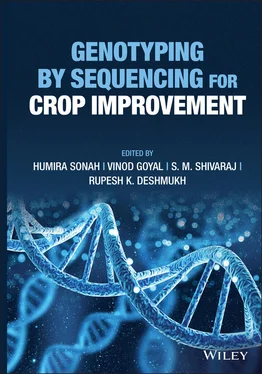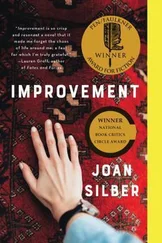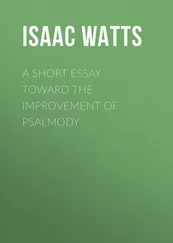Genotyping by Sequencing for Crop Improvement
Здесь есть возможность читать онлайн «Genotyping by Sequencing for Crop Improvement» — ознакомительный отрывок электронной книги совершенно бесплатно, а после прочтения отрывка купить полную версию. В некоторых случаях можно слушать аудио, скачать через торрент в формате fb2 и присутствует краткое содержание. Жанр: unrecognised, на английском языке. Описание произведения, (предисловие) а так же отзывы посетителей доступны на портале библиотеки ЛибКат.
- Название:Genotyping by Sequencing for Crop Improvement
- Автор:
- Жанр:
- Год:неизвестен
- ISBN:нет данных
- Рейтинг книги:4 / 5. Голосов: 1
-
Избранное:Добавить в избранное
- Отзывы:
-
Ваша оценка:
- 80
- 1
- 2
- 3
- 4
- 5
Genotyping by Sequencing for Crop Improvement: краткое содержание, описание и аннотация
Предлагаем к чтению аннотацию, описание, краткое содержание или предисловие (зависит от того, что написал сам автор книги «Genotyping by Sequencing for Crop Improvement»). Если вы не нашли необходимую информацию о книге — напишите в комментариях, мы постараемся отыскать её.
A thoroughly up-to-date exploration of genotyping-by-sequencing technologies and related methods in plant science Genotyping by Sequencing for Crop Improvement,
Genotyping by Sequencing for Crop Improvement
Genotyping by Sequencing for Crop Improvement
Genotyping by Sequencing for Crop Improvement — читать онлайн ознакомительный отрывок
Ниже представлен текст книги, разбитый по страницам. Система сохранения места последней прочитанной страницы, позволяет с удобством читать онлайн бесплатно книгу «Genotyping by Sequencing for Crop Improvement», без необходимости каждый раз заново искать на чём Вы остановились. Поставьте закладку, и сможете в любой момент перейти на страницу, на которой закончили чтение.
Интервал:
Закладка:
In contrast to the WGS, WGR helps in the comparison of the variable sequences present between the genome of an individual or the population. In the case of WGR, the species genome sequence is a prerequirement for the read mapping. For example, in the case of an individual, genomic DNA of high quality is fragmented for library preparation in which adaptors are added to the fragments with an average insert size of 350–500 bp. With the help of high‐throughput sequencing paired‐end, short reads of about 100 bp are obtained. These short reads based on sequence similarity are mapped on the reference genome. When a particular nucleotide differs from the species‐specific base single‐nucleotide polymorphisms (SNPs) are detected. In some cases, SNPs might get lost as these are not present in the reference genome while some are heterozygous. And others may get lost due to low coverage. In the case of the population, the aim is to obtain genomic data from a wide range of individuals which are analyzed as a whole and are sequenced. These techniques have a wide range of applications in conservation and management (Fuentes‐Pardo and Ruzzante 2017).
3.3 Whole‐Genome Resequencing Mega Projects in Different Crops
3.3.1 1K Arabidopsis Genomes Resequencing Project
Arabidopsis thaliana belongs to the family Brassicaceae. It has 125–150 Mb diploid genome having around 30,000 protein‐coding genes distributed over five chromosomes. Weigel and Mott (2009) initiated a project to report whole‐genome sequence variation in 1001 accession. To sequence species‐wide genome of the Arabidopsis, they proposed an approach with two different aspects. In the first aspect, by using the technologies such as Roche’s 454 platform they generated a small number of sequences that approach the quality of A. thaliana ’s original Col‐o (Columbia) reference. For a large number of sequence, a relatively less expensive technology for example Applied Biosystem’s SOLiD or Illumina’s Genome Analyzer was used. Local haplotype similarity was exploited by using the information from the reference genome to draw a complete genome sequence. In a second aspect of this approach, the sampling was done for ten individuals from ten populations and geographical regions all around the Eurasia and at least one accession from North Africa (10 × 10 × 10 + 1). The aim of this 1K Arabidopsis genome project was to sequence a generalized genome that can encompass every Arabidopsis accession and every genome of the A. thaliana can be completely aligned against it (Weigel and Mott 2009).
3.3.2 3K Rice Genomes Resequencing Project
Rice is the principal staple food and is grown worldwide. It has high genetic diversity within genus and species and the wise use of rice diversity is a major factor for improved production. hence exploring the diversity at the genome level is required. A genome sequence program to sequence known diversity across the species was launched by the collaboration of CAAS (Chinese Academy of Agricultural Sciences), BGI (Beijing Genomics Institute), and IRRI (International Rice Research Institute) and named “The 3K rice genome project.” The 3K rice genome project is the giga‐dataset of the genome that is available publicly (averaging 14× depth of coverage), derived from 3K rice accession which are genetically and functionally diverse set collected from 89 countries. The aim of the 3K rice genome project was that the new population‐specific genotyping arrays will be helpful for the genetic as well as breeding application and reveal population structure (Li et al. 2014a).
3.3.3 Soybean Whole‐Genome Resequencing
The WGR approach has been used in soybean to identify the Quantitative trait loci (QTL) determining colonization of arbuscular mycorrhizal fungi (AFM). The microbial community like AFM can associate with 80% of the terrestrial plants and help host plants to uptake more nutrients, provide tolerance against stresses. The colonization and extent of benefits provided by AFM depend on the host genotypes. QTL is responsible for mycorrhizal responsiveness in different plants. Pawlowski and coworkers investigated the genetic components that are involved in the AFM association. The aim of the study was the genome‐wide association analysis to identify the difference in AFM colonization in soybean genotypes and identification of genomic regions that are responsible for the colonization of AFM. They had used a genetically diverse set of 350 soybean genotypes inoculated with AFM (i.e. Rhizophagus intraradices ). By using whole‐genome resequencing‐derived SNP dataset, they identified six QTL involved in the colonization of the AFM. The candidate genes identified in these QTL regions contain the homologs of the nodulin protein family and other genes responsible for symbiosis (Pawlowski et al. 2020).
3.3.4 Chickpea
Cicer arietinum is the best source for protein, β‐carotene, and minerals such as iron, calcium, phosphorus, manganese, and zinc. Major abiotic stresses such as heat and drought can cause up to 70% loss in yield. Varshney and his coworkers utilize NGS technology to explore the germplasm wealth present in gene banks and provide information on genetic variation, domestication, and population structure of the 429 chickpea lines. They analyzed the 2.7 Tbp (terabase pair) raw data including 28.36 billion reads with around 6 Gbp (gigabase pairs) raw data per sample. By using mapped resequencing data, they reported a map of 4.97 million SNPs, 596 100 indels, 4931 CNVs, and 60 742 PAVs (presence–absence variation) in 429 reference genotypes set. Out of 4.97, million the most of the SNPs (i.e. 85%) were found in intergenic regions and around 4% were present in coding sequences. They identified 107 375 heterozygous and 20 544 homozygous SNPs by using SNP calling procedure. Genome‐wide association provides all the resources and generates new avenues for chickpea breeding in the future (Varshney et al. 2019).
3.3.5 Pigeon pea
Pigeon pea is an important tropical grain legume fulfilling the nutritional security in most of the developing countries such as Africa, Asia, and tropical America. The completion of the draft genome using high‐throughput techniques facilitated rapid detection of genomic variation among pigeon pea landraces, breeding lines, and wild species. Varshney and his coworkers generated the whole‐genome resequencing data for 292 accessions that include breeding lines (117 accessions), landraces (166), 7 from wild species, and 2 others. They had generated 21.7 billion paired‐end reads of 2.19 Tb sequence (101 bp in length) and mapped to the reference genome (Asha pigeon pea cultivar). These mapping results can be used for the identification of SNPs, INDELs, and larger‐scale variants along with CNVs and PAVs, such findings can accelerate the sustainability and improve the yield of the pigeon pea (Varshney et al. 2017).
3.3.6 Vitis
Vitis is native to temperate regions and having 30 wild species indigenous to East Asia and 28 wild species from North America. Liang and coworkers resequenced the whole genome of 472 Vitis accessions that cover 48 out of the 60 extant species from different geographical distributions. They had generated around 4.1 Tb WGS data, 27.3 billion paired‐end raw reads for 472 accessions. For the majority of accessions, the coverage was found more than 80%. By using different filter criteria, they identified the 77 726 929 SNPs, 10 278 017 indels, and 23K copy number of the variants. Next filtering yielded 27 859 960 SNPs, 3 854 659 indels with minor allele frequency (MAF) >0.005 and core set of about 12 549 273 SNPs and 9 lakh indels with MAF >0.005. Around 73.7% of the SNPs were present in the intergenic regions and around 4% of the SNPs were present in the coding region. All these outcomes from this study can play an important role in the improvement of the Vitis cultivars (Liang et al. 2019).
Читать дальшеИнтервал:
Закладка:
Похожие книги на «Genotyping by Sequencing for Crop Improvement»
Представляем Вашему вниманию похожие книги на «Genotyping by Sequencing for Crop Improvement» списком для выбора. Мы отобрали схожую по названию и смыслу литературу в надежде предоставить читателям больше вариантов отыскать новые, интересные, ещё непрочитанные произведения.
Обсуждение, отзывы о книге «Genotyping by Sequencing for Crop Improvement» и просто собственные мнения читателей. Оставьте ваши комментарии, напишите, что Вы думаете о произведении, его смысле или главных героях. Укажите что конкретно понравилось, а что нет, и почему Вы так считаете.












